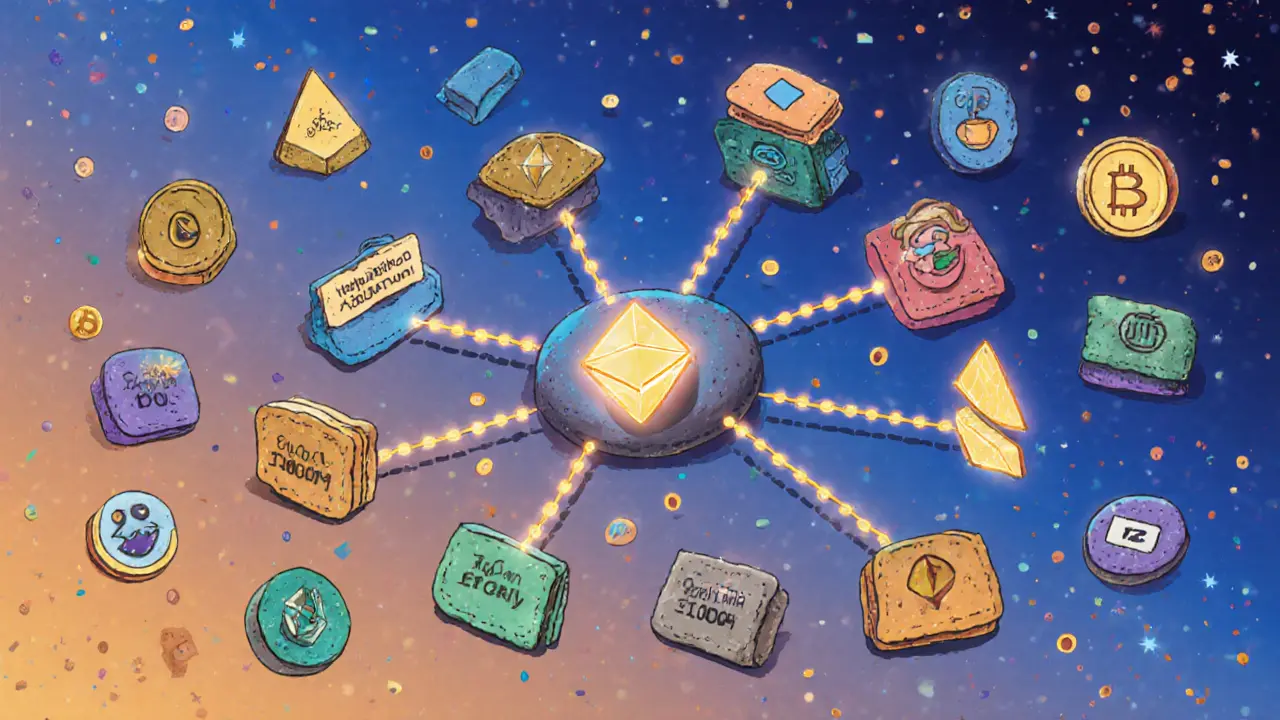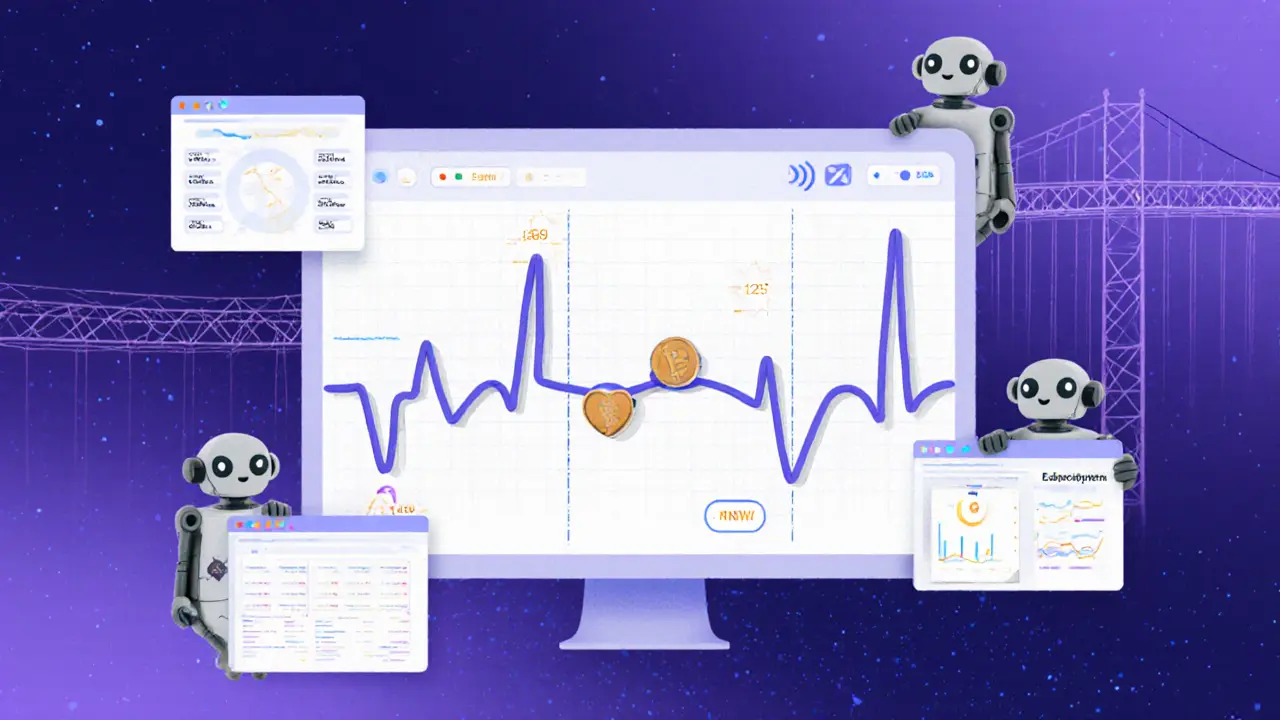Active Addresses and Network Activity: What They Really Tell You About Blockchain Health
 Dec, 25 2024
Dec, 25 2024
Blockchain Activity Simulator
Simulate how different types of network activity affect daily active addresses. See how airdrop farming, genuine user activity, and exchange transactions impact the metric. This tool demonstrates why active addresses alone don't tell the full story of blockchain health.
Activity Scenarios
Simulation Controls
Daily Active Addresses
What This Simulation Shows
Result: 5,750 Daily Active Addresses
While the total active addresses looks high (5,750), only 250 are genuine users. The rest (5,500) are either airdrop farms or exchange addresses. This simulation shows why we need to filter out exchange addresses and identify bot activity to understand true network health. When a real user base grows, active addresses show steady growth. When activity is mostly airdrop farming, you see spikes followed by crashes.
When you hear that Ethereum hit 650,000 daily active addresses, what does that actually mean? Is the network growing? Is it healthy? Or is it just people gaming the system with airdrop wallets? The truth is, active addresses are one of the most important numbers in blockchain analytics-but they’re also one of the most misunderstood.
What Exactly Are Active Addresses?
An active address is any wallet that has sent or received a transaction within a given time frame-usually daily, weekly, or monthly. It doesn’t matter if the transaction was for $1 or $1 million. It doesn’t matter if it succeeded or failed. Even if someone sent ETH to their own address, or miners collected fees from a failed swap, that address still counts.
Here’s how it works: every day, blockchain explorers scan millions of transactions. They pull out every sender and receiver address, then remove duplicates. The final count? That’s your Daily Active Addresses (DAA). For example, on February 24, 2023, Ethereum had 531,396 active addresses. That means 531,396 unique wallets were involved in any kind of on-chain activity that day.
This metric started gaining traction around 2013-2014, when early analytics platforms like Blockchain.com began tracking it. Today, tools from Coin Metrics, Santiment, and Nansen use the same basic logic: count unique addresses that touched the ledger. But it’s not just about sending money. On Ethereum, any address that interacts with a smart contract-staking, voting, claiming rewards, minting an NFT-is also counted as active.
Why Analysts Care About Active Addresses
Unlike transaction volume, which can be inflated by one person making 50 transfers in an hour, active addresses measure actual participation. If 100 people each send 10 transactions, you get 1,000 transactions but only 100 active addresses. That’s a cleaner signal of real user engagement.
Institutional investors rely on this metric because it’s hard to fake. You can’t easily manipulate the number of unique wallets interacting with a network. That’s why 78% of crypto hedge funds list active addresses among their top five tracked indicators, according to a 2022 PwC survey.
When DAA trends upward over weeks or months, it usually means people are using the network for real purposes-buying NFTs, swapping tokens, using DeFi apps. Delphi Digital found that blockchains with quarterly DAA growth above 20% were 3.2 times more likely to survive long-term than those with flat or falling numbers.
But here’s the catch: active addresses don’t equal users. One person can own five wallets. A trader might use different addresses for different strategies. A bot might send 100 transactions from 100 different addresses. So while the metric shows network usage, it doesn’t tell you how many actual humans are involved.
What Active Addresses Don’t Tell You
Let’s say Solana hits 3.2 million DAA in a single day. Sounds huge, right? But if that spike came from a single airdrop campaign-where users created dozens of wallets just to claim free tokens-then the number is meaningless. That’s exactly what happened in mid-2023 with the Blast protocol. Its DAA jumped 400% in June… then collapsed 92% two weeks later when the airdrop ended.
That’s why you can’t look at active addresses alone. You need context. Are fees rising? Is TVL (Total Value Locked) increasing? Are smart contracts being used for real applications, or just token swaps?
Another blind spot: exchange wallets. Most platforms like Coinbase or Binance use a handful of large addresses to handle millions of user deposits. Those addresses show up as “active” every day-even if the users inside never touched the blockchain themselves. That’s why Santiment and other professional tools automatically filter out the top 100 exchange addresses to get a clearer picture of organic activity.
And don’t forget smart contracts. A validator node on Ethereum’s proof-of-stake network is always active. It doesn’t mean people are using the network-it just means the infrastructure is running. Some platforms now track “Active Smart Contract Addresses” separately to avoid this distortion.

How to Interpret Active Address Trends
Looking at a single day’s number is useless. You need to see the trend.
- Is DAA rising steadily over 30 days? That suggests real adoption.
- Is it spiking and crashing? Probably a short-term event like an airdrop, NFT drop, or exchange listing.
- Is it flat or declining? Could mean users are leaving, or activity is moving to Layer 2s.
Most analysts smooth out the noise by using 7-day moving averages. Weekends always see lower activity, so raw daily numbers can be misleading. Tools like Token Terminal and Santiment apply these filters automatically.
Also, compare across chains. Ethereum usually hovers between 500,000-700,000 DAA. Solana peaked at over 3 million in 2023. But Solana’s ecosystem is built for speed and low cost-it attracts different users than Ethereum. A lower DAA on Ethereum doesn’t mean it’s failing; it might mean it’s handling more complex, high-value activity.
How to Access Active Address Data
You don’t need to be a developer to check this data. Free tools like Blockchain.com’s “Unique Addresses Used” chart give you a basic view. But if you’re serious, you’ll want more precision.
Professional platforms include:
- Coin Metrics: Offers historical DAA data with API access, including breakdowns by transaction type.
- Santiment: Tracks DAA and filters out exchange addresses. Also provides category splits-DeFi, NFT, Gaming.
- Nansen: Shows active addresses alongside wallet labeling (e.g., “whale,” “exchange,” “DeFi user”).
- Amberdata: Includes active address metrics under blockchain analytics dashboards.
Here’s the catch: different platforms calculate active addresses slightly differently. A 2023 CryptoCompare audit found up to 12% variation between providers. That’s why serious investors cross-check at least three sources before making decisions.

What’s Next for Active Address Metrics?
The field is evolving fast. In Q2 2023, Coin Metrics introduced “Active Blob Addresses” to track activity tied to Ethereum’s new proto-danksharding upgrade-where data blobs are stored on-chain. This lets analysts see if users are actually using the new feature, not just paying for it.
Token Terminal now breaks down active addresses by application type: how many are using DeFi? How many are minting NFTs? This helps answer whether growth is coming from real utility or speculation.
The biggest future shift? Machine learning. Researchers are training models to spot bot behavior-like wallets that send identical transactions every 30 seconds, or ones that exist only to claim airdrops. The goal is to create a “behavioral score” that distinguishes real users from fake ones.
Meanwhile, the Interchain Foundation is funding a $2.1 million project to build a “Unified Active Address Protocol” that would let you track activity across multiple blockchains in one metric. Right now, you can’t easily compare Ethereum DAA to Solana DAA because their transaction structures are different. That’s changing.
Final Takeaway: Use Active Addresses Wisely
Active addresses are not a magic number. They’re a starting point. They tell you that something is happening on the network-but not why, or whether it matters.
Combine them with:
- Transaction volume (total value moved)
- Fee revenue (do users pay to use the network?)
- TVL (how much value is locked in DeFi?)
- NVT Ratio (network value vs. transaction volume-like P/E for crypto)
And always ask: Is this growth real? Or is it temporary? Is it driven by users-or by bots and airdrop hunters?
If you see steady DAA growth, rising fees, and increasing TVL across a 90-day window? That’s a healthy network. If DAA spikes but fees stay flat and TVL drops? That’s noise. And noise doesn’t build lasting value.
Active addresses are the heartbeat of a blockchain. But you need the full EKG-multiple metrics, context, and time-to know if the patient is truly healthy.
What counts as an active address in blockchain?
An active address is any unique wallet that has sent or received a transaction-or interacted with a smart contract-within a specific time frame, such as a day, week, or month. This includes successful and failed transactions, transfers to self, miner rewards, and contract interactions. Each address is counted only once per period, regardless of how many times it was used.
Do active addresses equal real users?
No. One person can control multiple wallets, and bots or automated scripts can generate thousands of addresses. Exchange platforms also use large pooled addresses for deposits, which inflate the count. That’s why active addresses measure network activity, not human users. Professional tools filter out known exchange addresses to get a clearer picture of organic usage.
Why is DAA more useful than total transaction count?
Total transaction count can be inflated by one user making dozens of small transfers. DAA counts unique wallets, so even if someone sends 20 transactions in a day, they’re still just one active address. That makes DAA a better indicator of actual user participation and network engagement.
Which blockchains have the highest active addresses?
As of 2023, Solana reached over 3.2 million daily active addresses during its peak, largely due to high-volume NFT and airdrop activity. Ethereum typically maintains between 500,000 and 700,000 DAA, reflecting its role as the hub for DeFi and complex smart contracts. Bitcoin’s DAA is lower, usually under 1 million, because it’s primarily used for value transfer rather than application interaction.
How do I track active addresses myself?
Free tools like Blockchain.com’s “Unique Addresses Used” chart give basic data. For deeper analysis, use platforms like Santiment, Coin Metrics, or Nansen, which offer APIs, historical data, and filters to exclude exchange addresses. Most professional traders cross-reference at least three sources to account for methodological differences.
Can active addresses be manipulated?
Yes. Airdrop farming is the most common method-users create hundreds of wallets to claim tokens, then abandon them. This causes artificial spikes in DAA, as seen with the Blast protocol in June 2023. The spike lasted two weeks before collapsing by 92%. Analysts now use behavioral analysis and machine learning to detect these patterns and filter out fake activity.
What’s the future of active address metrics?
The next evolution includes behavioral scoring to distinguish bots from real users, cross-chain unified metrics, and category-specific tracking (e.g., DeFi vs. NFT activity). Projects like Ethereum’s proto-danksharding are already driving new variants like “Active Blob Addresses.” While DAA will remain important, its role is shifting from a standalone metric to one piece of a larger puzzle that includes fees, TVL, and user behavior.
Vijay Kumar
November 27, 2025 AT 07:23Active addresses? More like active scams. Everyone’s just farming airdrops like it’s a grocery store sale. You think this is adoption? Nah. It’s digital hoarding with a side of FOMO.